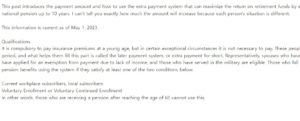This post introduces the payment amount and how to use the extra payment system that can maximize the return on retirement funds by extending the subscription period of the national pension up to 10 years. I can’t tell you exactly how much the amount will increase because each person’s situation is different.
This information is current as of May 1, 2023.
Qualifications
It is compulsory to pay insurance premiums at a young age, but in certain exceptional circumstances it is not necessary to pay. These people have no choice but to have a blank period, and what helps them fill this part is called the later payment system, or extra payment for short. Representatively, spouses who have been living as housewives, those who have applied for an exemption from payment due to lack of income, and those who have served in the military are eligible. Those who fall under this category can increase their pension benefits using the system if they satisfy at least one of the two conditions below.
Current workplace subscribers, local subscribers
Voluntary Enrollment or Voluntary Continued Enrollment
In other words, those who are receiving a pension after reaching the age of 60 cannot use this.

payment method
If you call the company, the person in charge will guide you. For the part not recognized as the subscription period, you can pay the full amount in a lump sum or pay in installments up to 60 times a month. You will receive a bill between the 11th and 15th of the month following the month you applied for, and you have to pay it by the last day.
Payment amount
Those who are currently paying pension as a business subscriber or a local subscriber can make a later payment with the same payment amount as the insurance premium paid in the month of application. Just because you couldn’t pay in the past doesn’t mean you’re paying the amount in the past, so don’t misunderstand. On the other hand, voluntary or voluntary continuous subscribers are the opposite of the situation mentioned above, but since there is no current payment, they have no choice but to pay within the limit of the amount set by the country. In principle, it is impossible to pay more than 9% of the A value, but as of 2023, the A value is 2,861,000 won. If you multiply this by 9%, you get the maximum premium you can pay as an extra payment, which is 257,490 won per month.
Usage
Everyone knows that if you extend the subscription period, you will receive more benefits, so it is beneficial. However, it is necessary to compare whether investing money in extra payments or investing in personal pension savings helps the rate of return. I will exclude risky assets that inevitably result in principal loss, such as stocks and real estate, for now.
Normally, if a person who has subscribed to the national pension for 20 years adds one year to the subscription period, the amount of the pension will increase by 5% per year. And if you bring another representative case, there was a person who paid only for 8 months and was a housewife for 20 years. has grown to If the average life expectancy is 85 years old, you will receive a pension for about 20 years. When you calculate the total amount of receipt, it is 199.2 million won, and the rate of return is 96% for 20 years, and the annual rate of return is about 5%.
From this point of view, if you have an investment of more than one billion units and are about to retire at the age of 60, it is better to increase the rate of return by paying extra, It is better to pay 6 million won a year in personal pension savings and pay up to 15% return on tax deductions rather than paying in installments for extra payments. When it comes time to retire later, it is better to pay off all at once with a lump sum.
So far, we have looked at the amount of the national pension extra payment system and how to use it. In addition, we have compiled a list of ways to increase your benefits and save on living expenses, so please refer to the information below.
5 Ways to Financially Plan for Living Expenses After Retirement
5 Ways to Save on Living Expenses Using the Rebate Scheme
How to get a utility bill and tax refund
How to Look Up Your Medical Refund in 3 Steps